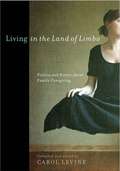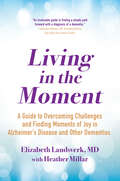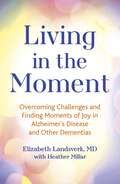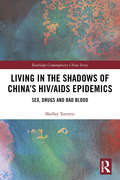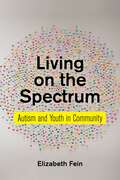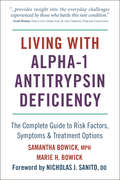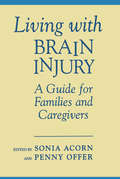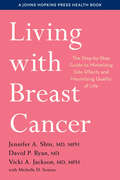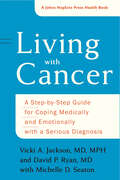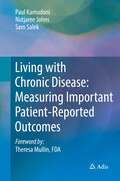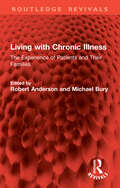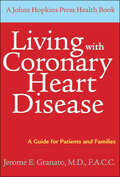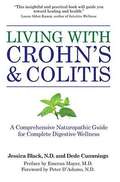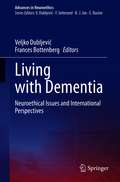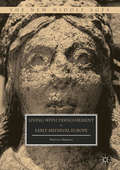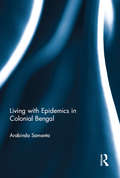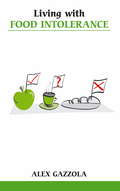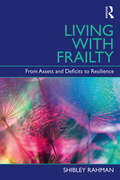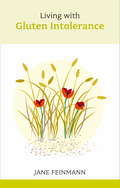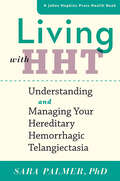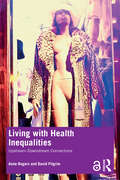- Table View
- List View
Living in the Land of Limbo: Fiction and Poetry about Family Caregiving
by Carol LevineLiving in the Land of Limbo is the first anthology of short stories and poems about family caregivers. These men and women find themselves in "limbo," as they struggle to take care of a family member or friend in the uncertain world of chronic illness. The authors explore caregivers' experiences as they deal with family conflicts, the complexities of the health care system, and the impact of their choices on their lives and the lives of others. The book includes selections devoted to caregivers of aging parents; husbands and wives; ill children; and relatives, lovers, and friends. A final section is devoted to paid caregivers and their clients. Among the conditions that form the background of the selections are dementia, HIV/AIDS, mental illness, multiple sclerosis, and pediatric cancer. Many of the authors are well-known poets and writers, but others have not been published in mainstream media. They represent a range of cultural backgrounds. Although their works approach caregiving in very different ways, the authors share a commitment to emotional truth, unvarnished by societal ideals of what caregivers should feel and do. These stories and poems paint profoundly moving and revealing portraits of family caregivers.
Living in the Land of Limbo: Fiction and Poetry about Family Caregiving
by Carol LevineAAUP Books Committee "Outstanding" Title of 2015Living in the Land of Limbo is the first anthology of short stories and poems about family caregivers. These men and women find themselves in "limbo," as they struggle to take care of a family member or friend in the uncertain world of chronic illness. The authors explore caregivers' experiences as they deal with family conflicts, the complexities of the health care system, and the impact of their choices on their lives and the lives of others. The book includes selections devoted to caregivers of aging parents; husbands and wives; ill children; and relatives, lovers, and friends. A final section is devoted to paid caregivers and their clients. Among the conditions that form the background of the selections are dementia, HIV/AIDS, mental illness, multiple sclerosis, and pediatric cancer. Many of the authors are well-known poets and writers, but others have not been published in mainstream media. They represent a range of cultural backgrounds. Although their works approach caregiving in very different ways, the authors share a commitment to emotional truth, unvarnished by societal ideals of what caregivers should feel and do. These stories and poems paint profoundly moving and revealing portraits of family caregivers.
Living in the Moment: A Guide to Overcoming Challenges and Finding Moments of Joy in Alzheimer's Disease and Other Dementias
by Elizabeth LandsverkAn invaluable, comprehensive guide that explains everything you and your family need to know about living well with Alzheimer&’s disease and other dementias. A loved one&’s dementia diagnosis can leave you feeling scared and overwhelmed. Now a renowned geriatrician who has helped thousands of families live happy, engaged lives—after a dementia diagnosis—shares her expertise in this easy-to-follow guide. Filled with must-have information, practical advice, and unique and comforting insights, here is everything you need to know about caring for your loved one and making his or her life the best possible—starting now, even as the disease progresses. Inside, you&’ll find: · How to create a plan of action for today—and tomorrow—that will help all involved cope with this new normal · How to keep your vulnerable loved one safe and secure—both physically and financially · Lifestyle changes, innovative new activities, and holistic interventions that can slow the progression of dementia · Comprehensive information on both prescription and OTC medications that can help or hurt dementia patients · Dealing with day-to-day challenges, from staying mobile to overcoming agitation and aggression without resorting to sedation · How and where to get help, including online support groups, home health care agencies, care managers, neuropsychologists, communities and day programs for people with dementia, and government agencies · Tips on keeping your loved one at home versus placement in a long-term care facility In addition to all the essential advice, Dr. Landsverk demystifies the ins and outs of dementia, explaining what it is and what it&’s not, and making sure you and your loved one will be ready to address whatever develops and maintain quality of life. Uniquely, Living in the Moment will transform how you think about dementia, providing comfort and support for the best life possible—at any stage.
Living in the Moment: Overcoming Challenges and Finding Moments of Joy in Alzheimer's Disease and Other Dementias
by Elizabeth LandsverkAn invaluable, comprehensive guide that explains everything you and your family need to know about living well with Alzheimer's disease and other dementias.A loved one's dementia diagnosis can leave you feeling scared and overwhelmed. Now a renowned consultant geriatrician, who has helped thousands of families live happy, engaged lives - after a dementia diagnosis - shares her expertise in this easy-to-follow guide.Filled with must-have information, practical advice, and unique and comforting insights, here is everything you need to know about caring for your loved one and making his or her life the best possible - starting now, even as the disease progresses. Inside, you'll find:* How to create a plan of action for today, and tomorrow, that will help all involved cope with this new normal* How to keep your vulnerable loved one safe and secure both physically and financially* Lifestyle changes, innovative new activities, and holistic interventions that can slow the progression of dementia* Comprehensive information on both prescription and over-the-counter medications that can help or hurt dementia patients* Dealing with day-to-day challenges, from staying mobile to overcoming agitation and aggression without resorting to sedation* How and where to get help* Tips on keeping your loved one comfortable in their own home In addition to all the essential advice, Dr. Landsverk demystifies the ins and outs of dementia, explaining what it is and what it's not, and making sure you and your loved one will be ready to address whatever develops and maintain quality of life. Uniquely, Living in the Moment will transform how you think about dementia, providing comfort and support for the best life possible - at any stage.
Living in the Shadows of China's HIV/AIDS Epidemics: Sex, Drugs and Bad Blood (Routledge Contemporary China Series)
by Shelley TorcettiIdentifying the existing challenges and shortfalls of China's current HIV/AIDS programming, this book provides an understanding of the history of HIV/AIDS in China, comparing government responses to global best practice in prevention and treatment. Considering three key populations in China, namely, female sex workers, people who inject drugs and floating migrants, Living in the Shadows of China's HIV/AIDS Epidemics highlights the effects of high mobility and marginalisation on the spread of HIV in China. It is argued that these groups often suffer from stigmatisation and a lack of human security, resulting in sub-optimal outcomes for HIV/AIDS intervention and prevention efforts and the reinforcement of high-risk behaviours, further contributing to the transmission of the virus to the general population. In adding to the emerging body of literature, this book further elucidates the myriad of challenges posed by HIV/AIDS epidemics, allowing sustained engagement and a fresh insight into how governments might respond to the needs of individuals living with HIV/AIDS, both in China and globally. Including case studies which give voice to research participants in a rich and engaging way, this book will appeal to students and scholars of Chinese Studies, Asian Studies, International Relations and Political Science, as well as those engaged in epidemiological studies in the Health Sciences.
Living on the Spectrum: Autism and Youth in Community (Anthropologies of American Medicine: Culture, Power, and Practice #8)
by Elizabeth FeinHonorable Mention, 2020 Stirling Prize for Best Published Work in Psychological Anthropology, given by the Society for Psychological AnthropologyHonorable Mention, New Millennium Book Award, given by the Society for Medical AnthropologyHow youth on the autism spectrum negotiate the contested meanings of neurodiversityAutism is a deeply contested condition. To some, it is a devastating invader, harming children and isolating them. To others, it is an asset and a distinctive aspect of an individual’s identity. How do young people on the spectrum make sense of this conflict, in the context of their own developing identity? While most of the research on Asperger’s and related autism conditions has been conducted with individuals or in settings in which people on the spectrum are in the minority, this book draws on two years of ethnographic work in communities that bring people with Asperger’s and related conditions together. It can thus begin to explore a form of autistic culture, through attending to how those on the spectrum make sense of their conditions through shared social practices.Elizabeth Fein brings her many years of experience in both clinical psychology and psychological anthropology to analyze the connection between neuropsychological difference and culture. She argues that current medical models, which espouse a limited definition, are ill equipped to deal with the challenges of discussing autism-related conditions. Consequently, youths on the autism spectrum reach beyond medicine for their stories of difference and disorder, drawing instead on shared mythologies from popular culture and speculative fiction to conceptualize their experience of changing personhood. In moving and persuasive prose, Living on the Spectrum illustrates that young people use these stories to pioneer more inclusive understandings of what makes us who we are.
Living with Alpha-1 Antitrypsin Deficiency: Complete Guide to Risk Factors, Symptoms & Treatment Options (Living with)
by Samantha Bowick Marie BowickA knowledgeable handbook with a patient's perspective for those afflicted with the incurable disease known as Alpha-1 Antitrypsin deficiency (A1AD).Alpha-1 Antitrypsin deficiency (A1AD) is a rare genetic, incurable disease which causes the liver to not produce enough of a certain protein that protects and keeps the lungs functional. 100,000 people in the United States have A1AD and 19 million more are carriers for the disease. Since it's so rare, the information available about A1AD has been lacking especially for those suffering unknowingly with the disease. Living with Alpha-1 Antitrypsin Deficiency offers the most up-to-date and comprehensive information on this illness and includes first-hand experience from someone managing the disease. Living with Alpha-1 Antitrypsin Deficiency also includes expert advice from doctors and researchers tackling the disease, with tips on recognizing symptoms and getting the most effective help possible.
Living with Brain Injury: A Guide for Families and Caregivers
by Sonia Acorn Penny OfferAn injury to the brain can affect every aspect of a person's daily life, including physical abilities and psychological make-up, relationships and family roles, school and employment, recreation and leisure. At the hospital, you may hear a lot about brain injury but not realize the importance of what you've learned until you have to deal with the injured person at home. In this handy reference book, health-care and legal experts from Canada and the United States guide you through the process of rehabilitation and help you learn how to live with brain injury. The advice of these professionals is complemented by the stories of two people who have survived injuries and are adjusting to their new lives.
Living with Breast Cancer: The Step-by-Step Guide to Minimizing Side Effects and Maximizing Quality of Life (A Johns Hopkins Press Health Book)
by Vicki A. Jackson David P. Ryan Jennifer A. ShinYour complete resource for handling the physical and emotional effects of breast cancer treatments.At the time of diagnosis, breast cancer patients are faced with many overwhelming decisions about possible treatments. Living with Breast Cancer provides you with an overview of what to expect from testing and treatment, which cancer specialists you may need to see, and common terms to use to help communicate your needs to your team. This empathetic resource full of relatable stories teaches patients and caregivers how to ask the right questions to get the best possible care. The authors explain how to minimize the symptoms and side effects of treatment and outline coping strategies to deal with the stress of breast cancer treatment, including the changes in your body from cancer and its therapies. The book helps readers• make sense of their diagnosis• set goals and prepare for treatment• understand the different types of therapies, tests, and scans• manage the symptoms and side effects of treatment, such as nausea, fatigue, shortness of breath, weight fluctuations, and depression• learn what medications and lifestyle modifications can help with symptoms• live and cope with progressive cancerLiving with Breast Cancer is your definitive resource for handling the physical and emotional effects of breast cancer and treatment.
Living with Cancer: A Step-by-Step Guide for Coping Medically and Emotionally with a Serious Diagnosis (A Johns Hopkins Press Health Book)
by Michelle D. Seaton Vicki A. Jackson David P. RyanA comprehensive and compassionate guide for patients and families living with the physical and emotional effects of cancer.The prospect of entering treatment is overwhelming for anyone facing a diagnosis of cancer. While patients have access to a vast amount of medical information online, this advice is often unreliable or confusing. In Living with Cancer, Drs. Vicki A. Jackson and David P. Ryan have crafted the first step-by-step guide aimed at helping people with this life-defining disease grasp what’s happening to them while coping physically and emotionally with cancer treatment. An empathetic resource full of relatable patient stories, this book teaches patients and caregivers how to ask the right questions to get the best possible care—beginning at the moment of diagnosis. Drs. Jackson and Ryan explain how to work with a team of doctors and nurse practitioners to minimize symptoms and side effects while living as fully as possible in the face of cancer. They relay important information about understanding prognosis, and they translate what doctors mean when they describe tests, treatments, and medical procedures. Finally, they discuss hospice care and answer questions about continuing treatment and managing the final phase of life.Based on new research and a groundbreaking program in which patients are treated with palliative care—along with the best cancer care—during the course of their illness, this honest and caring book provides the right advice to use at the right time throughout a journey with cancer. It allows a person with cancer to concentrate on living the best life possible, despite an uncertain future. Patients at every stage will find Living with Cancer a comprehensive, thoughtful, and accessible guide for navigating the illness and its treatment.
Living with Chronic Disease: Measuring Important Patient-Reported Outcomes
by Sam Salek Paul Kamudoni Nutjaree JohnsThis book serves as a roadmap for the development and application of patient-reported outcome (PRO) measures, supporting beginners through to experts, as a practical guide. To elucidate on key concepts in the book, examples from clinical research in hyperhidrosis and health-related quality of life and medicines clinical development context, are used. Health-related quality of life represents one of the most commonly measured PROs in both routine clinical practice and research. The book demonstrates the importance of PROs to patients with chronic disease and how such outcomes can assist clinicians in managing patients and monitoring their response to treatment in terms of both symptoms and impacts. This book will benefit readers as a single-source practical guide on the development of modern PRO measures and may also serve as a blueprint for the conceptualization and planning of evidence generation related to PROs in various settings. Ideas and suggestions on how to navigate recent developments shaping the field of PRO measurement are also offered.
Living with Chronic Illness: The Experience of Patients and Their Families (Routledge Revivals)
by Michael Bury Robert AndersonFirst published in 1988, Living with Chronic Illness presents a vivid account of the reality of life with chronic illness – from the perspective of patients and their families. The authors look at the expectations, priorities, and problems of those most affected by chronic illness, and examine the strategies they have developed to cope with their considerable disadvantages. The experience of carers, the ways in which their problems change over time, are also major themes in the book.The book looks at the everyday life of people with the following conditions: stroke, renal failure, multiple sclerosis, Parkinson’s disease, arthritis, heart attack, epilepsy, rectal cancer, psoriasis, and diabetes. In each case, an overview of the consequences of a particular illness is presented, before discussion of specific problems in daily life – maintaining family relationships, managing treatment regimes, coping with work and home commitments, and living with bodily change and social stigma.This volume will be of importance to all those concerned with providing support and planning care for the chronically ill – in the health and social services and in voluntary organizations. Students of medical sociology, policy makers and planners will also find the insights and research presented here valuable in the understanding of the daily life of people with chronic illness. It will also be of use for those in professional training, in nursing, social work, general practice and related areas.
Living with Coronary Heart Disease: A Guide for Patients and Families (A Johns Hopkins Press Health Book)
by Jerome E. GranatoCoronary heart disease kills more people in the United States than any other heart disorder, and it is the leading cause of death among American women. Jerome E. Granato, a distinguished cardiologist with more than twenty-five years of experience, has created an authoritative and accessible guide to this common condition, providing patients and their families with insight and advice. Dr. Granato begins by describing the basic science of the disease, known also as atherosclerosis, in which arteries become clogged and damaged. He then explains who is at risk and how the disease is detected and diagnosed. He covers all the treatment options, from medications to surgery, and answers such questions as: • How do I know if I have coronary heart disease?• What is a heart attack?• Does my condition need to be treated with surgery?• What are the benefits and risks of balloon angioplasty?• What are stents and how do they work?• How can I manage my condition for the future?He addresses the needs of specific populations, and concludes by discussing how a healthy diet and regular exercise can influence health before and after treatment and how it can help prevent disease. Even after coronary heart disease is diagnosed, its course can be modified. This valuable resource will help patients and their families make some of the most important health care decisions they will ever face.
Living with Crohn’s & Colitis: A Comprehensive Naturopathic Guide for Complete Digestive Wellness
by Jessica Black Dede CummingsApproximately 1. 5 million people in the United States alone are afflicted with inflammatory bowel disease (IBD), a category of illnesses that includes Crohn's disease and ulcerative colitis, and that number is steadily growing.
Living with Dementia: Neuroethical Issues and International Perspectives (Advances in Neuroethics)
by Veljko Dubljević Frances BottenbergThis book addresses current issues in the neuroscience and ethics of dementia care, including philosophical as well as ethical legal, and social issues (ELSIs), issues in clinical, institutional, and private care-giving, and international perspectives on dementia and care innovations. As such, it is a must-read for anyone interested in a well-researched, thought-provoking overview of current issues in dementia diagnosis, care, and social and legal policy. All contributions reflect the latest neuroscientific research on dementia, either broadly construed or in terms of the etiologies and symptoms of particular forms of dementia. Given its interdisciplinary and international scope, its depth of research, and its qualitative emphasis, the book represents a valuable addition to the available literature on neuroethics, gerontology, and neuroscientific memory research.
Living with Disfigurement in Early Medieval Europe
by Patricia SkinnerThis book is open access under a CC-BY license. This book examines social and medical responses to the disfigured face in early medieval Europe, arguing that the study of head and facial injuries can offer a new contribution to the history of early medieval medicine and culture, as well as exploring the language of violence and social interactions. Despite the prevalence of warfare and conflict in early medieval society, and a veritable industry of medieval historians studying it, there has in fact been very little attention paid to the subject of head wounds and facial damage in the course of war and/or punitive justice. The impact of acquired disfigurement --for the individual, and for her or his family and community--is barely registered, and only recently has there been any attempt to explore the question of how damaged tissue and bone might be treated medically or surgically. In the wake of new work on disability and the emotions in the medieval period, this study documents how acquired disfigurement is recorded across different geographical and chronological contexts in the period. This book is open access under a CC-BY license.
Living with Epidemics in Colonial Bengal
by Arabinda SamantaMaking epidemics in colonial Bengal as its entry point and drawing heavily on social, cultural and linguistic anthropology to understand the functions of health experiences, distribution of illness, prevention of sickness, social relations of therapeutic intervention and employment of pluralistic medical systems, the book interrogates the social construction of medical knowledge, politics of science, and the changing paradigm of relationship between health of the individual and the prerogatives of larger colonial economic formations. Smallpox, plague, cholera and malaria which visited colonial Bengal with epidemic vengeance, caught the people unaware, killed them in thousands, and changed the society and its demographic structures. The book shows how sometimes through mutual adaptation but more often by cultural contestation, people pulled on with their microbial fellow travellers, and how illness became metaphor for the social dangers of improper code of conduct, to be corrected only through personal expropriation of the sin committed, or by community worship of the deity supposedly responsible for it. As a result, Western medical science was often relegated to the background, and elaborate rites and rituals, supposedly having curative values, came to the forefront and were observed with much community fanfare. Epidemics were also interpreted as outcome of politically incorrect moves made by the ruling power. To right the wrongs, people very often resorted to social protest. The protest by the literati went sometimes muted when its members seem to be beneficiaries of the colonial government, but it turned out to be all the more violent when the people, who had no private axe to grind, took up the cudgel to fight it out.
Living with Food Intolerance
by Alex GazzolaIdentify troublesome foods and find the diet that suits you. Food intolerance is common and involves an adverse reaction to a particular food. Far more people suffer from food intolerance than they do from food allergy, and it's important to distinguish the two. This book will cover: our relationship with food - historical background; what food intolerance is and isn't; difference between intolerance and allergy; other problems with foods - aversions, phobias, food poisoning; types, symptoms and possible causes of intolerance; how to seek an accurate diagnosis; managing and living with your intolerance; preventing recurrences.
Living with Food Intolerance
by Alex GazzolaIdentify troublesome foods and find the diet that suits you. Food intolerance is common and involves an adverse reaction to a particular food. Far more people suffer from food intolerance than they do from food allergy, and it's important to distinguish the two. This book will cover: our relationship with food - historical background; what food intolerance is and isn't; difference between intolerance and allergy; other problems with foods - aversions, phobias, food poisoning; types, symptoms and possible causes of intolerance; how to seek an accurate diagnosis; managing and living with your intolerance; preventing recurrences.
Living with Frailty: From Assets and Deficits to Resilience
by Shibley RahmanIncreasingly, we question ‘what makes us healthy?’, as well as ‘what makes us ill?’. What does this shift mean for frailty? Almost wholly defined in negative terms, the term ‘frail’ tends to refer to a group of older people who are at highest risk of adverse outcomes such as falls, infections, disability, admission to hospital or the need for long-term care. This ground-breaking book takes a holistic approach to frailty. It connects the medical literature with the wider social science discourse on ageing, and focuses on promoting wellbeing and the building up of strengths. Living with Frailty draws together the latest biomedical evidence and good practice in this emerging area and explores ideas about assets and resilience, the role of society and the social model of disability in relation to frailty, arguing that insufficient attention is paid to positive action such as developing bone strength, maintaining good nutrition and exercising. Chapters look at: existing models of frailty person-centred care assessing frailty and quality of life how falls, and fear of falls, relate to discussions of frailty delirium and frailty the environment and frailty sarcopenia. Living with Frailty is an important introduction and reference for all practitioners, researchers and students with an interest in frailty, wellbeing and social approaches to health. Forewords by Professors Ken Rockwood, Dalhousie University, and Adam Gordon, Nottingham University.
Living with Gluten Intolerance: How To Be Separate And Connected
by Jane FeinmannGluten intolerance is poorly understood by doctors and frequently misdiagnosed, for example as irritable bowel disorder. This book gives clear information on both coeliac disease and gluten intolerance, explains how they differ from other digestive disorders, and looks at possible treatments as well as self-help measures.
Living with Gluten Intolerance: How To Be Separate And Connected
by Jane FeinmannGluten intolerance is poorly understood by doctors and frequently misdiagnosed, for example as irritable bowel disorder. This book gives clear information on both coeliac disease and gluten intolerance, explains how they differ from other digestive disorders, and looks at possible treatments as well as self-help measures.
Living with HHT: Understanding and Managing Your Hereditary Hemorrhagic Telangiectasia (A Johns Hopkins Press Health Book)
by Sara PalmerEverything you need to know about nosebleeds, arteriovenous malformations, and other symptoms of HHT.Hereditary Hemorrhagic Telangiectasia (HHT) is a rare genetic disorder that causes blood vessel abnormalities in the nose, skin, gastrointestinal tract, lungs, brain, and liver. Nosebleeds are the most common symptom of HHT, but abnormal vessels in other organs, if they are not diagnosed and treated, can lead to serious medical complications, including stroke, hemorrhage, anemia, and brain abscess. Psychologist Sara Palmer, who has HHT herself and is an expert in helping people cope with health conditions, draws on current research as she thoroughly describes the symptoms of HHT, explains how the diagnosis is made (and often missed), and details treatment options. While addressing the medical aspects of HHT, Palmer also reveals how people affected by the disorder can maintain their emotional health, take care of family members, and live life as fully as possible. Enriched with illustrations, personal stories of people living with HHT, a glossary, and contact information for the HHT Centers of Excellence (which provide coordinated medical treatment for people with the disorder), Living with HHT is a complete resource for individuals with HHT and their families. This guide is also essential for health professionals seeking more information about this underdiagnosed disease.
Living with Health Inequalities: Upstream–Downstream Connections
by David Pilgrim Anne RogersThis book explores how people encounter, understand, live with and respond to health risks associated with social, economic and political inequality. Complementing a traditional public health approach, the book moves beyond a focus on categories of morbidity and their structural causes. Instead, it focuses on everyday understandings and actions for people living in unequal social conditions. Making use of a variety of case studies related to physical and mental health, the authors emphasise interpersonal relationships, biographical meanings and the daily tactics of ‘getting by’. These are recurrently linked to the social-structural aspects of particular times and places. The book: Draws upon, applies and extends the biopsychosocial approach, which is well known to students of public health. Respects and gives due weight to the experience in context of people who live with health inequalities, in domestic and local settings. Explores notions of personal agency and the contingencies of everyday life, in order to offer a focused psycho-social compliment to a public health tradition dominated by top-down reasoning. This is an important read for all those seeking to understand the complexities of health inequalities holistically in their studies, research and practice. The book brings together thinking in the fields of public health, sociology, mental health and social policy.
Living with Health Inequalities: Upstream–Downstream Connections
by David Pilgrim Anne RogersThis book explores how people encounter, understand, live with and respond to health risks associated with social, economic and political inequality. Complementing a traditional public health approach, the book moves beyond a focus on categories of morbidity and their structural causes. Instead, it focuses on everyday understandings and actions for people living in unequal social conditions. Making use of a variety of case studies related to physical and mental health, the authors emphasise interpersonal relationships, biographical meanings and the daily tactics of ‘getting by’. These are recurrently linked to the social-structural aspects of particular times and places.The book: Draws upon, applies and extends the biopsychosocial approach, which is well known to students of public health. Respects and gives due weight to the experience in context of people who live with health inequalities, in domestic and local settings. Explores notions of personal agency and the contingencies of everyday life, in order to offer a focused psycho-social compliment to a public health tradition dominated by top-down reasoning. This is an important read for all those seeking to understand the complexities of health inequalities holistically in their studies, research and practice. The book brings together thinking in the fields of public health, sociology, mental health and social policy.The Open Access version of this book, available at http://www.taylorfrancis.com, has been made available under a Creative Commons [Attribution-Non Commercial-No Derivatives (CC-BY-NC-ND)] 4.0 license.
